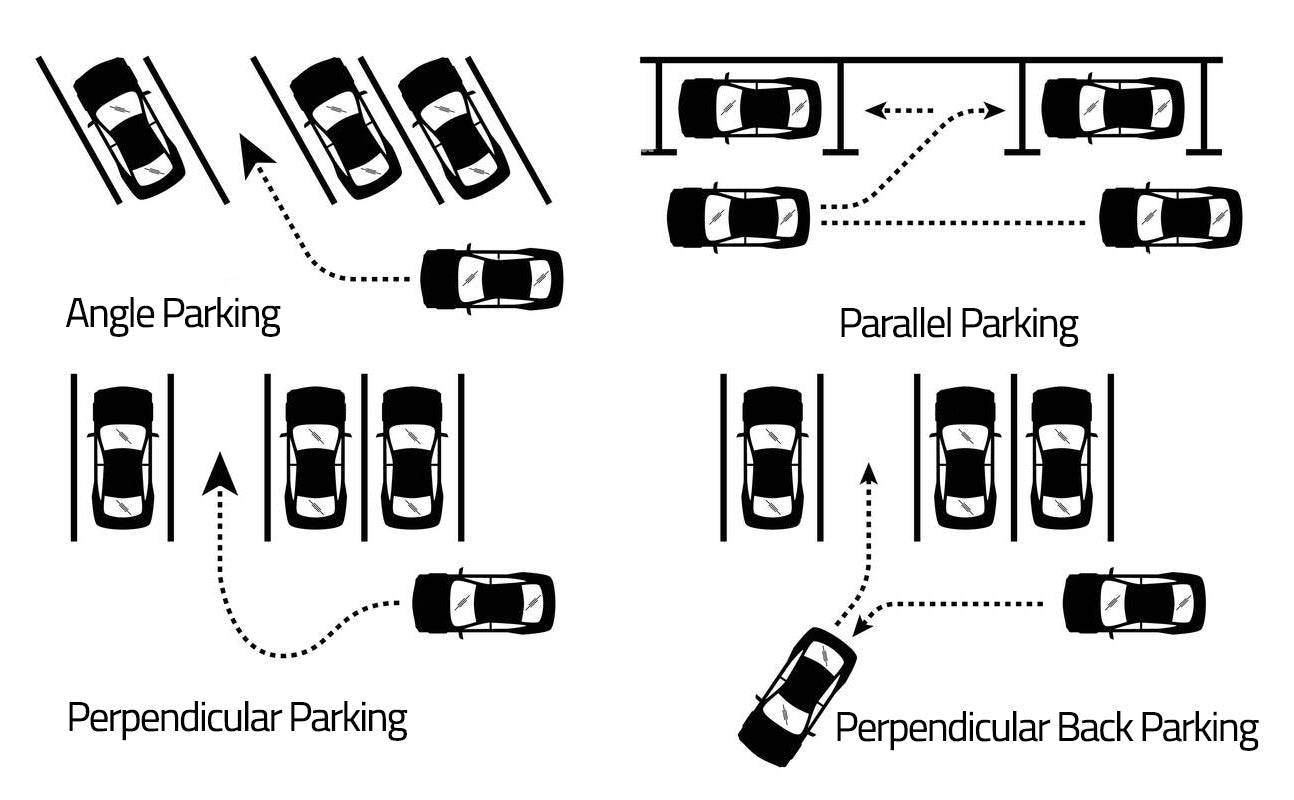The Ultimate Guide to Parking Space Dimensions
Starting an asphalt line striping business? Having the right tools and understanding the right dimensions before you start is important to your success and efficiency.
But before you get to painting lines on a lot, you need to know the dimensions of the parking spots you will have.
In the United States alone, there are roughly 1-2 billion parking spaces, approximately four spaces for every car in the country.
With such a large amount of parking spaces, there isn’t a one size fits all answer to how large a parking space is. With handicapped spots, oversized vehicles, truck parking, and more, there is plenty of variation in parking space size.
With that said, there are some standards that are observed and good rules of thumb to follow if you are painting parking lots or parking spaces.
In this guide, we will provide all the information you need about parking space dimension, so you can accurately design and paint your parking lot.
Dimensions of a Parking Space
Not every parking space has the same dimensions, and different sizes are needed to accommodate different vehicles and drivers.
The simplest way to break down the different types of parking space is into three different groups, standard, truck, and handicapped/accessibility. These three types of parking space have different requirements and considerations that need to be fulfilled.
Standard Parking
There is not a hard and fast rule for the exact size of a standard parking spot. They make up the majority of parking spots in most lots, and you’ll see plenty of them out and about.
Within standard parking spots, we can roughly say that there are three different dimensions that you will see, compact, standard, and large. The differences might seem small, but what dimensions you choose will impact everything about your lot.
Larger spots can decrease the number of spots in your lot and cause more accidents even though you might not think so. On the other hand, if you go with spots that are too small customers and drivers with bigger cars may not be able to fit in your parking spaces.
A compact space will be about 16 feet long by 8 feet wide. This will fit most compact cars, but larger pickup trucks and SUVs may struggle to fit in. Some parking lots have spots designated for compact cars that are denoted by a sign.
The standard parking space that you will see is roughly 18 feet long by 8 ½ feet in width. This is the most common parking space dimension that you will see.
Finally, some lots go for larger standard spots around 20 feet long by 9 feet in width. You will see these often in communities with lots of larger cars like agricultural communities, or big box stores like Walmart or Costco.
If you have a small lot in a strip mall or near a school, you might want to maximize the number of spaces you can have. But it is important to consider all potential users when you paint your lot and ensure they can fit and park in your lot.

Truck and Trailer Parking
Long-haul trucking is essential to day-to-day business in the United States, and there are millions of parking spots specifically designed to accommodate these bigger vehicles.
There’s no way that a semi-truck could fit in a standard parking spot, so parking lot owners will either design a whole lot for these vehicles, like a tuck stop, or have a limited number of spots for trucks or other oversized vehicles.
These vehicles need plenty of space and the spots for trucks need to be at least 15 feet wide and 30-40 feet long.
Due to the large footprint of truck parking spots, many city councils and municipilaties have strict rules for where these spots can and cannot be. So, it’s important to know the rules and regulations in your area before you get to planning and painting.
Handicapped Accessibility Parking
Parking lots of every size have to include handicapped accessibility parking as set out by the Americans with Disabilities Act (ADA). These spots allow handicapped users to access parking facilities in a safe manner.
A typical handicapped space has to be 8 feet wide and for van spaces 11 feet wide. Additionally, each spot needs to have a 5-foot-wide access aisle.
The required number of accessible handicapped spots varies by the parking lot size, for example a parking lot with 401-500 spots needs a minimum of 9 accessible parking spaces. Before you start painting your lot, consult the ADA requirements.
Parking Patterns and Layouts

The parking spot size is not the only consideration you will have to make when setting up and striping your lot. There are various pattern and layout choices that you can make that will optimize your parking situation based on your situation.
You have three pattern options when painting a parking spot, angled, perpendicular, and parallel.
We will break down the positives and negatives of each parking pattern here.
Perpendicular Parking Pattern
A perpendicular parking spot is at 90-degree angle, and it is one of the most common parking patterns you will see because it maximizes the number of parking spaces you can have in many settings.
In this layout, cars will be parked side by side and are perpendicular to the curb. In a square or rectangular parking lot, this is most often the most efficient way to fit in as many spots as possible.
There are some situations where perpendicular parking is not possible, which brings us to our next parking pattern.
Parallel Parking Pattern
Parallel is most frequently seen on the street, however it can also be used in parking lots to help maximize parking in awkwardly size areas.
With this parking pattern, cars will be parked parallel to the sidewalk or wall. This makes it a good option to add extra spaces when there is not enough room for perpendicular parking spaces. However, it would be inefficient to design an entire parking lot with parallel parking spots.
Angled Parking Pattern
Finally, you can use an angled parking pattern. The angle of the parking instead of being 90 degrees, will be at an angle typically ranging from 30-75 degrees.
Many drivers find this to be the easiest type of parking spot to park, so it is a go to get drivers quickly in and out of a space. It requires some additional space, but it is still common to see in parking structures and lots.
Other Factors to Consider
Now that you have a better idea of what type of parking patterns you can use, we will look at some other factors to consider when striping an asphalt parking lot.
One-Way or Two-Way?
Before painting your lot, you need to decide if your parking lot aisles will be one-way or two-way.
A two-way aisle needs more space because cars need enough room to pass other drives coming the opposite direction. Therefore, you need about 20 feet of clearance between the parking spaces on either side.
Therefore, some parking lot owners decide to go for a one-way aisle, as this requires less space. You might think you’ll save twice the space as a two-way aisle, but it’s not that simple. Even if you opt for a one-way aisle, other factors including the parking space angle will determine how wide you need to make your aisle.
Parking Space Angles and Aisle Width
While a 90-degree angle may be the most efficient manner to pack parking into a square surface lot, a wider-angle parking requires a wider clearance between each aisle. Drivers need enough space to safely turn out of their spot, so a narrow angle of 30 degrees requires a shorter aisle width than perpendicular parking.
For this reason, you are more likely to see parallel parking with narrow angles in areas where only a narrow aisle can fit, such as a parking garage.
So, it’s important to have all your measurements in order before you break out your line striper and get to work.
Entry and Exit Spacing
This is perhaps the most important consideration to make, especially for busy parking lots. In order to have a smoothly operating parking lot, you need to have properly spaced entry and exit points that prevent traffic jams and a clogged parking lot.
There are a variety of factors to consider when creating your entry and exit points, such as the volume of car traffic on the adjacent street, sidewalks and pedestrians, how close is your lot to an intersection, do you need to accommodate right and left turns, etc.
To prevent traffic jams, entry and exit points are typically spaced at least 300 feet away from an intersection. If the intersection is particularly busy with a long light cycle, you may want to consider increasing the entry and exit point distance from the intersection.
Handicapped Accessibility
In America, accessibility for the handicapped is federally mandated so as to ensure everyone with a car can access parking facilities.
Make sure to know the exact federal and local requirements in this area so as to prevent fines, the need to repaint your lot, and to ensure everyone can properly access your parking facility.
Standard spots need to be 8 feet wide, and 11 feet wide for vans.
Frequently Asked Questions
These are questions that we often get from parking lot owners and line striping companies. We’ll answer them here.
What is the most efficient parking space design?
This depends on the dimensions of your lot and other physical features in your facility. Generally speaking, a perpendicular spot will allow you to maximize the number of spots in your lot. However, this type of spot requires wider aisle spaces. So, if you are not in a large square or rectangular lot, an angled parking spot may be the way to go because it requires less aisle space. The angled spot is great for tight spaces such as parking garages or small lots. Parallel spots also have plenty of utility and can be used to fill in awkward gaps and maximize the total number of spots in your lot.
How big is a parking spot?
This depends on the type of spot, however we’ll provide the answer for the most common type of parking spot, a standard spot. On average, a standard parking spot is about 180 square feet. But the more spots you have, the more square footage you have to dedicate to other amenities such as aisle space and exit and entry point.
What's a Minimum Parking Requirement?
A minimum parking requirement is the amount of parking spaces a building is required to have based on its size. In America, most cities and towns have minimum parking lot requirements laid out in their zoning code that dictate how much parking is required for every size of building. The required parking is calculating by taking the size of a building and dividing it by a certain number set out by the governing body.
What is a Parking Ratio?
A parking ration is simply the square footage of a building divided by the number of parking spaces in its lot. For example, a 20,000 square foot building with 100 parking spaces has a ratio of 5 parking spaces per 1,000 square feet.
Final Words
We hope this will help you better understand how to properly line stripe your next parking lot project. If you are looking to offer more services in your asphalt maintenance business, be sure to check out our line of crack filling machines and asphalt sealcoat spraying machines.


